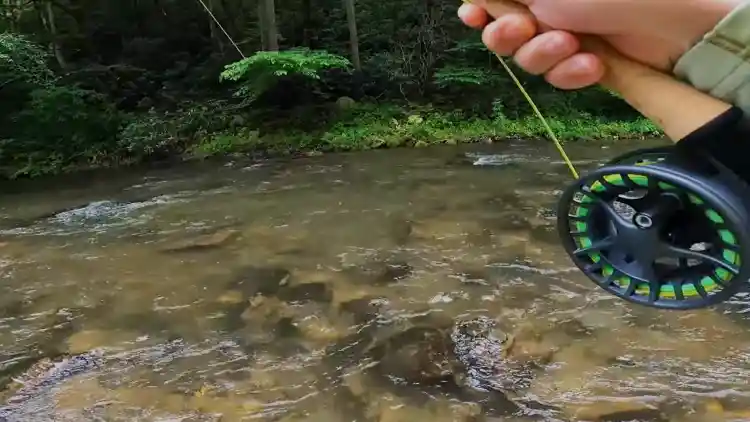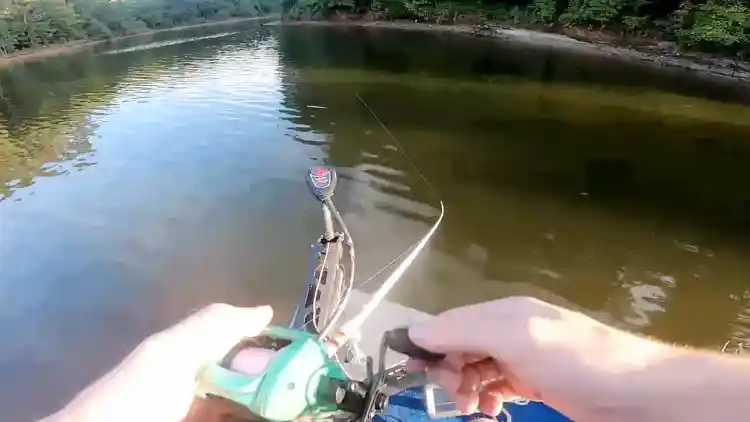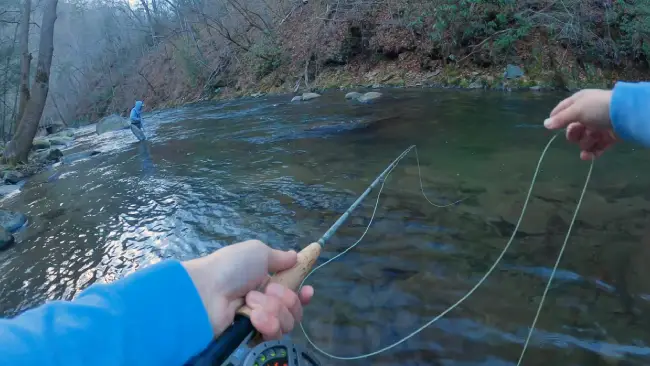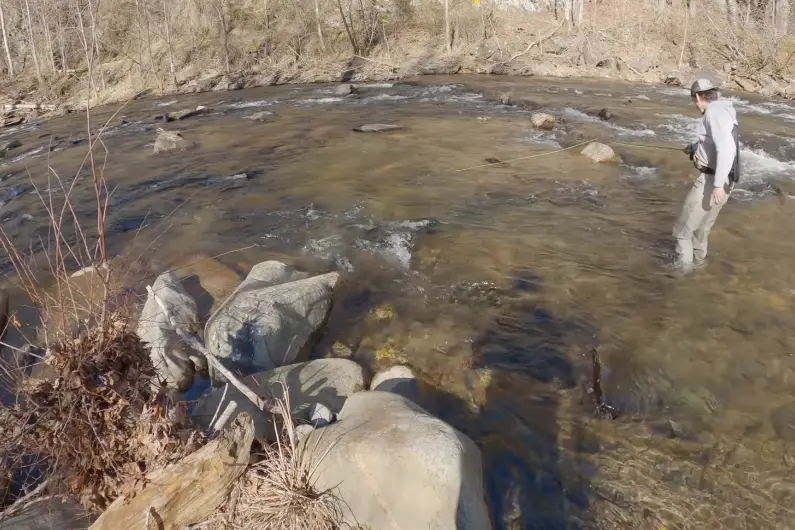Key Takeaways
- North Carolina offers diverse fly fishing locations, from mountain streams to lakes and coastal waters, providing opportunities to catch various fish species.
- Optimal fly fishing in North Carolina is during spring (April to May) and fall (September to November), with early mornings and late afternoons being the best times to fish.
- Anglers can target different fish species using fly fishing techniques, including trout (rainbow, brook, and brown), bass (smallmouth and largemouth), musky, striped bass, redfish, and more.
- Before heading out to fish, obtain a valid fishing license and familiarize yourself with specific regulations for each fish species, including size limits, daily creel limits, and open seasons.
- North Carolina’s fly fishing spots cater to all skill levels, offering challenges and rewards. Guides in certain locations enhance the experience and boost success rates.
List of the Top Fly Fishing Locations in North Carolina

There are tons of fly fishing opportunities in North Carolina. Some of the most popular places are:
- Davidson River
- Raven Fork
- Oconaluftee River
- Lake Fontana
- Watauga River
- Nantahala River
- South Mills River
- Wilson Creek
- South Toe River
- Mitchell River
- Bridges of Dare County
- Oregon Inlet
- Nolichucky River
- Rocky Broad River
- Shearon Harris Lake
- Falls of Neuse Lake
- Helton Creek
- Linville River
- Green River
Let’s take a closer look at these amazing fly-fishing spots:
1. Davidson River
- Located in Pisgah National Forest, Brevard, NC.
- Abundant rainbow, brook, and occasional large brown trout. “Big D” below Pisgah Fish Hatchery holds large fish due to nutrient-rich water.
- Guides are available for assistance to make your fishing experience easier and more productive.
2. Raven Fork
- Flowing out of the Smoky Mountains National Park, Ravens Fork flows through Cherokee, home to the Eastern Band of Cherokee Indians.
- Specially designated trophy water with large trout, including state record brook trout.
- Recommended flies for this location are zebra and blood midges, San Juan worms, and terrestrial patterns for the best catches.
3. Oconaluftee River
- Flows through the Great Smoky Mountains, Western NC, 30 miles long, joins the Tuckasegee River.
- Stocked twice a week with rainbow, brown, brook, and palomino trout. One of the best places to find the biggest trout in the state, with rainbows known to approach 30 inches.
- Recommended flies to use when out fishing are BWOs, midges, stoneflies, and caddis for the best catches.
4. Lake Fontana
- A 10,000-acre lake with warm water species located in Graham and Swain counties.
- Perfect for productive shore fishing, but boat access is recommended for the full experience. Small feeder streams provide trout fishing opportunities.
- Suitable for catching large and smallmouth bass, walleye, lake trout, and muskie, making it a versatile location for fishermen of all interests.
5. Watauga River
- Offers fly fishing opportunities for varying skill levels, accessible from Valle Crucis Community Park and Watauga River Gorge Access area.
- A large river with an abundance of room for casting and exploring.
- Provides fly fishing opportunities for trout and other species in a diverse ecosystem and landscape.
6. Nantahala River
- It’s in western North Carolina, close to the Great Smoky Mountains National Park, in the Nantahala National Forest.
- The upper reaches offer small stream fishing with native brook trout, while the lower sections are stocked with rainbow and brown trout.
- Offers diverse fly fishing opportunities throughout the year, making it a popular destination for anglers of all skill levels.
7. South Mills River
- Located in Pisgah National Forest.
- Recognized as one of the top 100 trout streams in the country. The specialty is wild brown, brook, and rainbow trout.
- You’ll have to hike a bit to reach the best fishing spots, but the experience is worth it.
8. Wilson Creek
- Wilson Creek is located in the Grandfather District of Pisgah National Forest in the northwestern section of Caldwell County, North Carolina.
- Rainbow, brown, and brook trout can all be found in this location.
- Fish are eager to take a fly due to less fishing pressure, providing a perfect opportunity for a successful fly fishing trip.
9. South Toe River
- Located in Yancey County in Western North Carolina.
- The upper portions of this river are designated as a wild trout stream, while the lower parts are stocked.
- Offers a fantastic dry fly fishery with giant stoneflies, caddis, and mayflies, making it perfect for those interested in catching trout.
10. Mitchell River
- Located in the Blue Ridge Mountains, Alleghany County, flows southeast through Surry County and joins the Yadkin River near Elkin.
- Surrounded by rainforest-like surroundings with shallow banks and deep, pocket water. This location is more focused on presentation than fly choice for optimal results.
- Mostly brown and rainbow trout around 9-15 inches can be found in this location, providing a great opportunity for fishers to practice their craft.
11. Bridges of Dare County
- It is situated in the easternmost county of North Carolina, Dare County.
- The bridges provide the perfect opportunity to catch striped bass with fly rods using clouser minnows.
- As an excellent saltwater fly fishing destination, the bridges offer great access to striped bass.
12. Oregon Inlet
- Located along North Carolina’s Outer Banks, separating Bodie Island from Pea Island.
- The fish range from 20 to 27 inches, making this an excellent destination for catching striped bass.
- A 7 or 8-weight rod with chartreuse closures is recommended.
13. Nolichucky River
- The 115-mile long river flows through Western North Carolina and East Tennessee.
- A warm-water fishery with incredible smallmouth, largemouth, and musky fishing, along with fat rainbow fish during winter.
- It offers diverse fly fishing opportunities that provide a unique experience for both experienced and novice fly fishermen.
14. Rocky Broad River
- Runs parallel to Main Street in Chimney Rock Village and stretches through Chimney Rock State Park.
- The river offers great smallmouth bass fishing and occasional largemouth.
- Slightly warmer than other trout streams in the state.
15. Shearon Harris Lake
- Located in New Hill, North Carolina.
- Provides world-class largemouth bass fishing due to the excellent aquatic vegetation that provides great habitat.
- The lake is a popular fly fishing destination, and using topwater poppers, plugs, and streamers can be productive.
16. Falls of Neuse Lake

- You’ll find it 15 miles east of downtown Durham, in Durham and Wake counties.
- This lake is a world-class largemouth bass fishery, allowing one to catch a trophy bass.
- White and chartreuse streamers are recommended for fly fishing due to people’s successes with these types of flies.
17. Helton Creek
- Located in Ashe County and is part of North Carolina’s delayed-harvest trout program.
- A treasure for anglers, the creek is stocked with approximately 26,600 catchable-size trout annually.
- The creek’s delayed harvest section offers near solitude and provides a unique fly fishing experience unmatched in the state.
18. Linville River
- Flows through North Carolina’s western region, passing through communities such as Grandfather, Linville, Pineola, Crossnore, and Linville Falls in Avery County.
- It is home to trout and other fish species and provides a unique opportunity for fly fishing.
- The Linville Gorge section, accessed via the Linville Gorge Trail, provides a spectacular scenic view perfect for a fly fishing expedition.
19. Green River
- The tailwater river in Polk County, the Green River, begins in the Blue Ridge Mountains of North Carolina and flows through the Blue Ridge Escarpment into the Piedmont.
- The river’s diversity of fish species and its unique fishing experience make it a worth-visit destination for any fly fishing enthusiast.
- This tailwater river is easily accessible with public access and provides various fly fishing opportunities for different trout species.
When is the optimal time for fly fishing in North Carolina?
The best time for fly fishing in North Carolina is during the spring (April to May) and fall (September to November) seasons. Early morning and late afternoon are ideal for fly fishing during these seasons.
The Davidson River in Pisgah National Forest, Helton Creek in Ashe County, and the Linville River are great spring fly fishing locations. These rivers offer abundant rainbow, brook, and brown trout.
In the fall, the Nantahala River in Nantahala National Forest, Wilson Creek in Pisgah National Forest, Lake Fontana in Graham and Swain counties, the Dare County Bridges in Outer Banks, and Oregon Inlet are excellent fly fishing locations.
What fish species can you catch in North Carolina using fly fishing?
You can catch a variety of fish species using fly fishing techniques. Here are some of the fish species that you can catch in North Carolina using fly fishing:
Trout species: You can use fly fishing to catch rainbow trout, brook trout, brown trout, and palomino trout in various rivers and streams, including the Davidson River, Nantahala River, Wilson Creek, Mitchell River, and more.
Warm Water species: If you’re looking for warm water species, you can use fly fishing to catch smallmouth bass, largemouth bass, and musky in locations like Nolichucky River, Shearon Harris Lake, Falls of Neuse Lake, and Lake Fontana.
Saltwater species: If heading to the Outer Banks, you can target various saltwater species using fly fishing, including striped bass in Dare County Bridges and Oregon Inlet.
Redfish: You can use fly fishing techniques to target bull redfish in the coastal marshes.
What are the regulations for fly fishing in North Carolina?

In North Carolina, there are many regulations related to fishing categories. The following are among them:
Fishing Licenses:
- Individuals aged 16 and older require a valid fishing license for public waters (excluding private ponds).
- Short-term licenses are available for inland and coastal fishing, with varying costs for residents and non-residents.
- Annual licenses are offered for inland and coastal fishing, with different fees for residents and non-residents.
- Lifetime licenses are available for comprehensive inland fishing and unified inland/coastal fishing (Residents only).
- Special licenses for disabled veterans, totally disabled individuals, and legally blind individuals.
Fish Species Regulations:
Various fish species have specific regulations for size limits, daily creel limits, and seasons in inland fishing waters.
Popular species and their regulations include:
- Flounder: Minimum size 15 inches, daily creel limit of 1, open season from September 1 to September 30.
- Red Drum: 18-inch minimum size limit; only one may be greater than 27 inches, no closed season.
- Seatrout: Minimum size of 14 inches, daily creel limit of 4, no closed season.
- Atlantic Croaker: No size limit, daily creel limit of 50, no closed season.
- Black Drum: Minimum 14-inch size, daily creel limit of 10, no closed season.
- Bluefish: No size limit, daily creel limit of 3, no closed season.
- Cobia: 36-inch minimum size limit, 1 creel limit per day, open season from May 1 to December 31.
- King Mackerel: 24-inch minimum size limit, 3 creels per day, no closed season.
- Mullet: No size limit, total daily creel limit of 200 in combination, no closed season.
- Sharks: No sharks may be possessed in inland fishing waters.
- Sheepshead: minimum 10-inch size limit, limit of 10 creels a day, no closed season.
- Spanish Mackerel: 12-inch minimum size limit, 15 creels per day, no closed season.
- Spot: No size limit, 50 creels a day, no closed season.
- Tarpon: No tarpon may be possessed in inland fishing waters.
- Weakfish: 12-inch minimum size limit, daily creel limit of 1, no closed season.
Keep in mind that fishing regulations may change over time, so it’s essential to stay updated with the latest guidelines to ensure responsible and compliant fishing practices.

